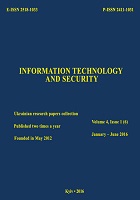Аpplication of functional and relational models in object-oriented programming
DOI:
https://doi.org/10.20535/2411-1031.2017.5.1.120559Keywords:
Object-oriented programming, programs formalization, relational model, functional model, active dynamic connections of objects.Abstract
The paper presents the results of research and practical approbation of formal methods for describing object-oriented programs suitable for automatic generation of programs text to the programming language. As formal models, the functional and relational models are used. The functional model represents the program as a scheme of the connection of functional atomic objects that are capable of direct interaction by forming dynamic connections and automatic computations, which can be represented graphically. In this case, the connection scheme of objects is considered as a scheme of task solving. It is shown that the formalization of the task solution scheme, rather than the entire programming paradigm, makes the process of program creating more suitable for the practice. The requirements for atomic objects are determined as such, which form the elemental basis of the object-oriented program. The relational model represents the object as a virtual relationship, the scheme which is specified by the class that implements the functional dependence of non-key attributes from the key ones by their calculations, which makes it possible to apply relational operations to describe the scheme of task solving. The relational model allows using a language which is similar to the structured query language of databases, to describe the scheme of solving the task and to perform it automatically. It is shown that the functional and relational models are suitable for graphical representation of the task solution scheme and are sufficiently expressive for direct generation of programs. In fact, the developed models allow us to increase the process of creating object-oriented programs to a higher level, focusing on the structure of the program, rather than on its components, and to eliminate the lack of methods for presenting programs. The programming technology of active dynamic connections of objects has been used as a basis for practical implementation.
References
D.B. Buy, S.V. Kompan, “Formalization of objects, classes, methods in the object-oriented databases”, in International conference of Problem of theoretical cybernetics, Nizhniy Novgorod, 2011, pp. 81-85.
D.B. Buy, S.V. Kompan, “Diagrams of classes of OOP : formalization and analysis”, Proc. institute of the applied mathematics and mechanics, vol. 27, Donetsk, pp. 51-65, 2013.
A.G. Piskunov, Formalization of paradigm of the object-oriented programming. [Online]. Available: http://www.realcoding.net/dn/docs/machine.pdf. Accessed on: Jan. 19, 2016.
D. Buy, S. Kompan, “The Concepts of Object, Class, Inheritance, LifeCycle: Formalization”, in Proc. of the First International Workshop Critical infrastructures safety and security (CrlSS-Dessert’11). Kirovograd, 2011, pp. 236–244.
E.M. Lavrishcheva, “Generating and assembly programming. Aspects of developing families of software systems”, Cybernetics and Systems Analysis, vol. 49, No. 1, pp. 129-144, 2013.
L.L. Omelychuk, Formal Methods of Program Specification. Kyiv, Ukraine: UkrINTEI, 2010.
V.N. Redko, “Existential Foundations of the Compositional Paradigm”, Cybernetics and Systems Analysis. № 2, pp. 3-12, 2008.
V. Sokolov, “Programming technology of active dynamic connections of objects” in V scientific conference Priority directions of development of telecommunication systems and networks for special purposes, Kyiv, 2010, p. 232.
Downloads
Published
How to Cite
Issue
Section
License
Copyright (c) 2020 Collection "Information technology and security"

This work is licensed under a Creative Commons Attribution 4.0 International License.
The authors that are published in this collection, agree to the following terms:
- The authors reserve the right to authorship of their work and pass the collection right of first publication this work is licensed under the Creative Commons Attribution License, which allows others to freely distribute the published work with the obligatory reference to the authors of the original work and the first publication of the work in this collection.
- The authors have the right to conclude an agreement on exclusive distribution of the work in the form in which it was published this anthology (for example, to place the work in a digital repository institution or to publish in the structure of the monograph), provided that references to the first publication of the work in this collection.
- Policy of the journal allows and encourages the placement of authors on the Internet (for example, in storage facilities or on personal web sites) the manuscript of the work, prior to the submission of the manuscript to the editor, and during its editorial processing, as it contributes to productive scientific discussion and positive effect on the efficiency and dynamics of citations of published work (see The Effect of Open Access).

